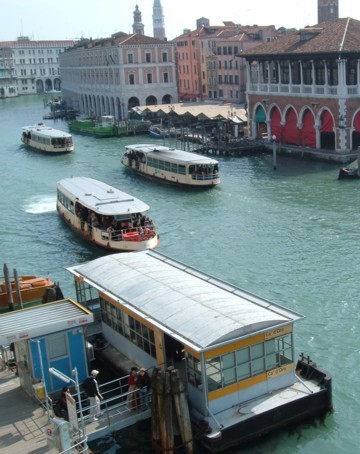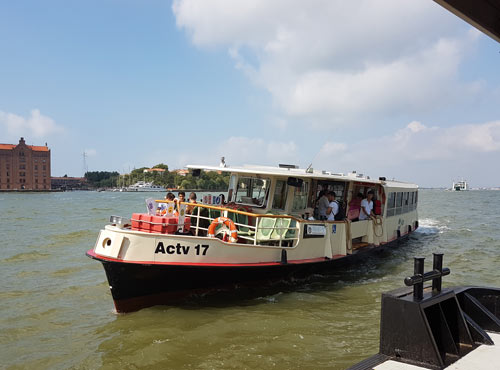There are just two ways to get around Venice: on foot and by boat. Consequently Venetians tend to be a healthy and fit people, with (for Italy) an unusually effective and respected public transport system.
Arriving in Venice
Most tourists will arrive in Venice via the road and railway bridges, which cross the lagoon side by side and arrive in the north-western corner of the city. The road finishes at Piazzale Roma, where there are rows of bus stops in the main open square. There is also car parking, but as a hire car is an expensive and unnecessary option once you’re in the city, consider carefully whether you need one. There is a tourist information office at Piazzale Roma, and a few yards away is the Grand Canal, lined with waterbus jetties. The railway station, Venezia Santa Lucia, is a short distance away on the other side of the wide canal, across a footbridge. This is also a busy ferry stop, named Ferrovia for the railway.
> More about arriving in Venice
> Arriving at Piazzale Roma
Get around Venice
Venice’s Grand Canal, lagoon shores and surrounding islands are well-served by waterbuses: the workaday vaporetti and the faster motoscafi. Away from the large waterways, travel is on foot, so be prepared to do plenty of walking when exploring the smaller alleys and canals. Don’t expect to get from A to B as directly or as quickly as you could in a normal, landbound city. Boats, including water taxis, must follow the navigable canals so journeys can be tortuous and slow. The Grand Canal winds through Venice like an inverted ‘S’, and the waterbuses which follow its course take some time to traverse the city. Similarly, pedestrians must find their way along a maze of alleys and are frequently impeded by dead-ends or by the need to find a bridge across an unexpected canal.
It is possible to tour Venice solely on foot, but if you are staying for any length of time, you’ll find the vaporetti very useful. There will be times when you are the wrong side of the Grand Canal, far from the four bridges which cross it, and want to use a vaporetto to hop across. Or times when your feet are hurting from all the walking and you just want to sit down and admire the view from the outdoor seat of a boat. And the only way to see the whole of the Grand Canal is by water.
For the best way to get around, we recommend a comfortable pair of shoes, a very good map – including ferry routes – and a travelcard.
> Finding your way around
Vaporetti
The word vaporetto originally referred to little steamers which plied Venice’s waters, but nowadays the term is loosely used to describe the city’s various types of public ferry service. Other terms you may hear are motoscafo, battello (boat) and its Venetian dialect version bateo. Venice’s waterbuses vary in size and comfort. Most have seats inside and out – the outdoor ones, of course, are the favourites of tourists. Sitting in the open at the back or front of a vaporetto is one of the very best ways of enjoying the Grand Canal. Round the outside of the island, waters can get choppy, making an outdoor seat rather more exciting, and sometimes damp. In the winter months, don’t forget to wrap up very warmly if you’ll be spending much time on the water. Vaporetti can get very crowded, and tourists should be alert to the crew’s instructions to move down inside the boats.
Some useful routes are 1 and 2, which run the length of the Grand Canal. The 1 calls at every stop as far as the Lido; the 2 is a faster service with fewer stops. Water buses 41 and 42 call at the cemetery island, San Michele, and at the glass-making island of Murano. The quickest service between Piazzale Roma and Murano is the 3. At night there is a nocturnal service, the N, which follows the Grand Canal. The network is quite complicated so if you’re planning a lot of travel it’s worth getting hold of a route-map.
Boats stop and moor alongside a floating jetty (the word for mooring is approdo). At a major stop like Piazzale Roma there are many pontoons where boats pull up – check the numbers displayed on the stop, and the direction of travel. If you’re at all unsure, query your destination with a member of staff.
Services are run by ACTV, who operate a bewildering range of fares. It’s expensive to travel around Venice, and it’s worth doing some research to make sure you don’t pay more than you have to. A free timetable booklet (orario) containing route-maps and fare information is sometimes available at the ACTV offices in Piazzale Roma, when they haven’t ‘run out’, and PDF timetables as well as a journey planner can be found on their website.
Fares and tickets
You should buy tickets in advance (stock up at a ticket kiosk by the major stops), although you can buy single tickets on board if you ask a crew member straight away. The first time you use your ticket you must validate it before travel by inserting it to be date-stamped in one of the yellow machines on the jetty, or by touching it to a sensor, depending on the type of ticket.
Check the ACTV website for the latest fares. It may be worth some planning ahead to work out whether multi-day options may suit you best and save money over using single tickets.
If you are in Venice for a longer period, it is possible to purchase a non-residents Carta Venezia, a photographic ID card which is extremely expensive, but may enable a long-term or frequent visitor to save money in the long run. Once you have one of these cards, you can use it to purchase carnets of single tickets at residents’ rates, making individual journeys very cheap once you’ve covered the initial outlay.
There is an ACTV ticket office between Piazzale Roma and the canal which has ticket desks inside and outside, and this is a good place to sort out your travel tickets on arrival. Visiting the ticket offices by the Rialto at off-peak times is also a good way to sort out your tickets or Carta Venezia purchases. Note that if you havepurchased any of the Venice tourist cards you may be entitled to free or discounted travel.

Traghetti
These are unadorned rowing boats with two rowers which run a ferry service at six points along the Grand Canal, crossing backwards and forwards. You can take a traghetto for a cheap and brief taste of travel in a gondola. Locals crowd on and make the crossing standing up, which can be nerve-racking when crossing the wake of a vaporetto. The traghetto services generally only operate in the daytime.
Water taxis
Water taxis offer a costly alternative means of transport in Venice. They can also be hired for private tours. There are taxi stands on the Grand Canal and at Marco Polo airport – the telephone number for taxi organisation Consorzio Motoscafi Venezia is +39 041 522 2303. The council’s website publishes a list of official tariffs (look under tariffe taxi).
Travelling around the lagoon
There is a network of ferries which travel beyond Venice itself, crossing to Murano and to the Lido and heading towards the remoter islands such as Burano and Torcello. On the Lido, the long strip of land between the lagoon and the sea, there are bus services also operated by ACTV.
Further afield
It’s not too hard to travel onwards from Venice, but if you are planning daytrips in the Veneto you do need to consider the extra time it may take you if you have to begin your journey by crossing Venice on foot or by boat. Trains run from Venice’s Santa Lucia Station all over Italy, although for some services you may need to change at the mainland station Venezia Mestre. Padua and Verona are among the interesting towns which can be visited by train from Venice. Buses depart from Piazzale Roma and cover the region.
Strikes
Our final piece of advice is tocheck to see whether a strike (sciopero) is scheduled on your travel dates – these are highlighted on the ACTV website. While the operators may be able to guarantee a limited service, it’s safer not to rely on public transport during the hours when a strike is planned.
On this site
Useful external links
